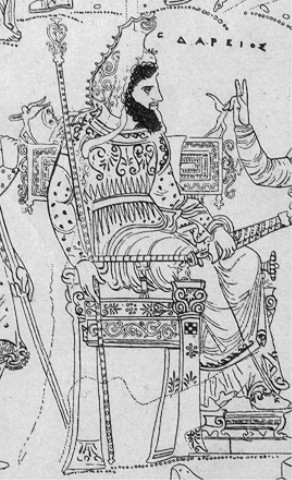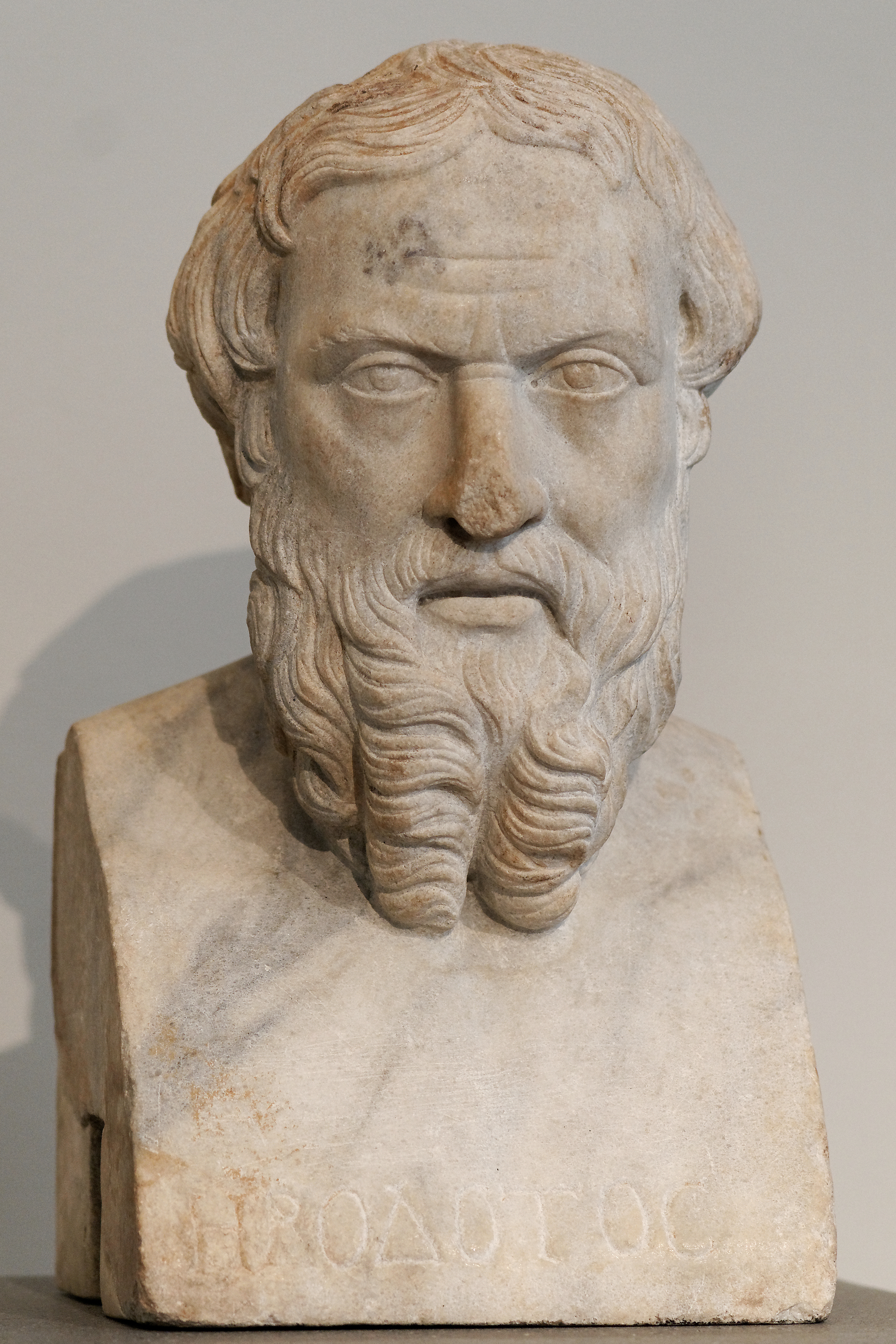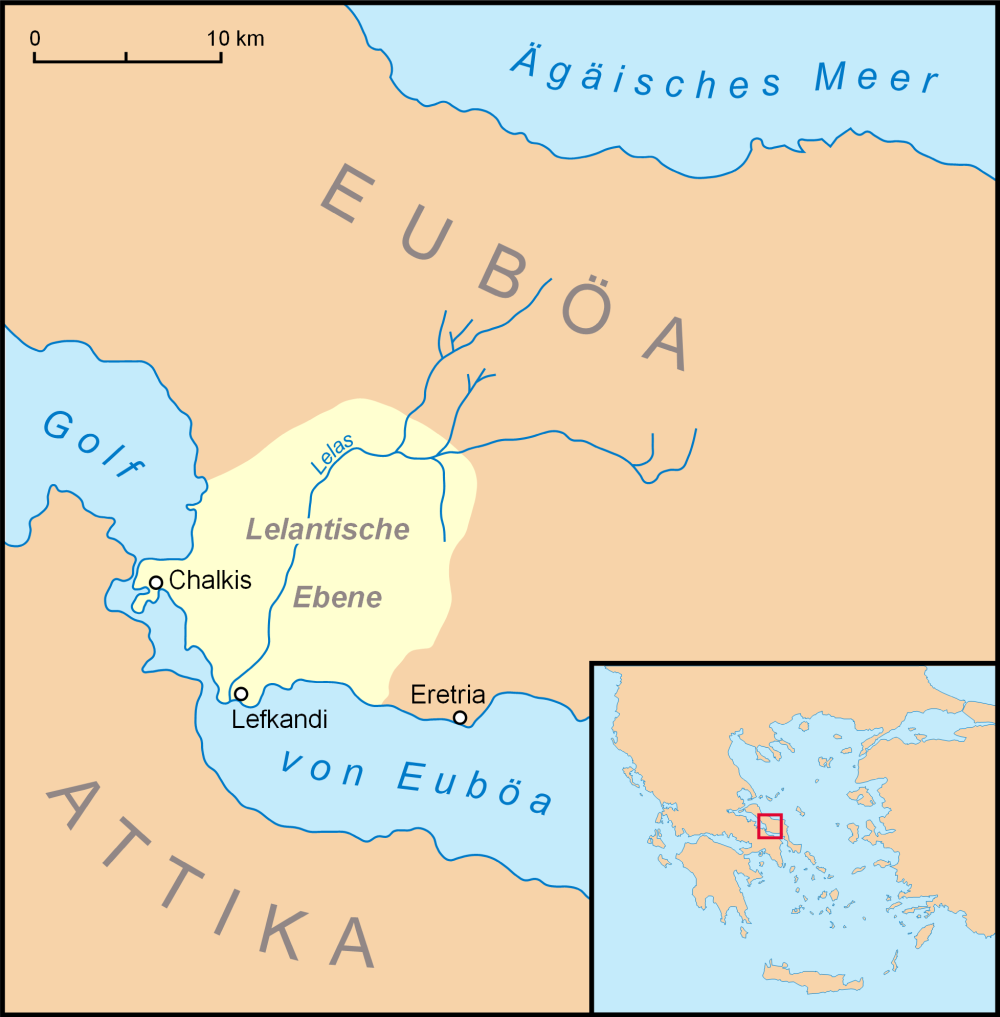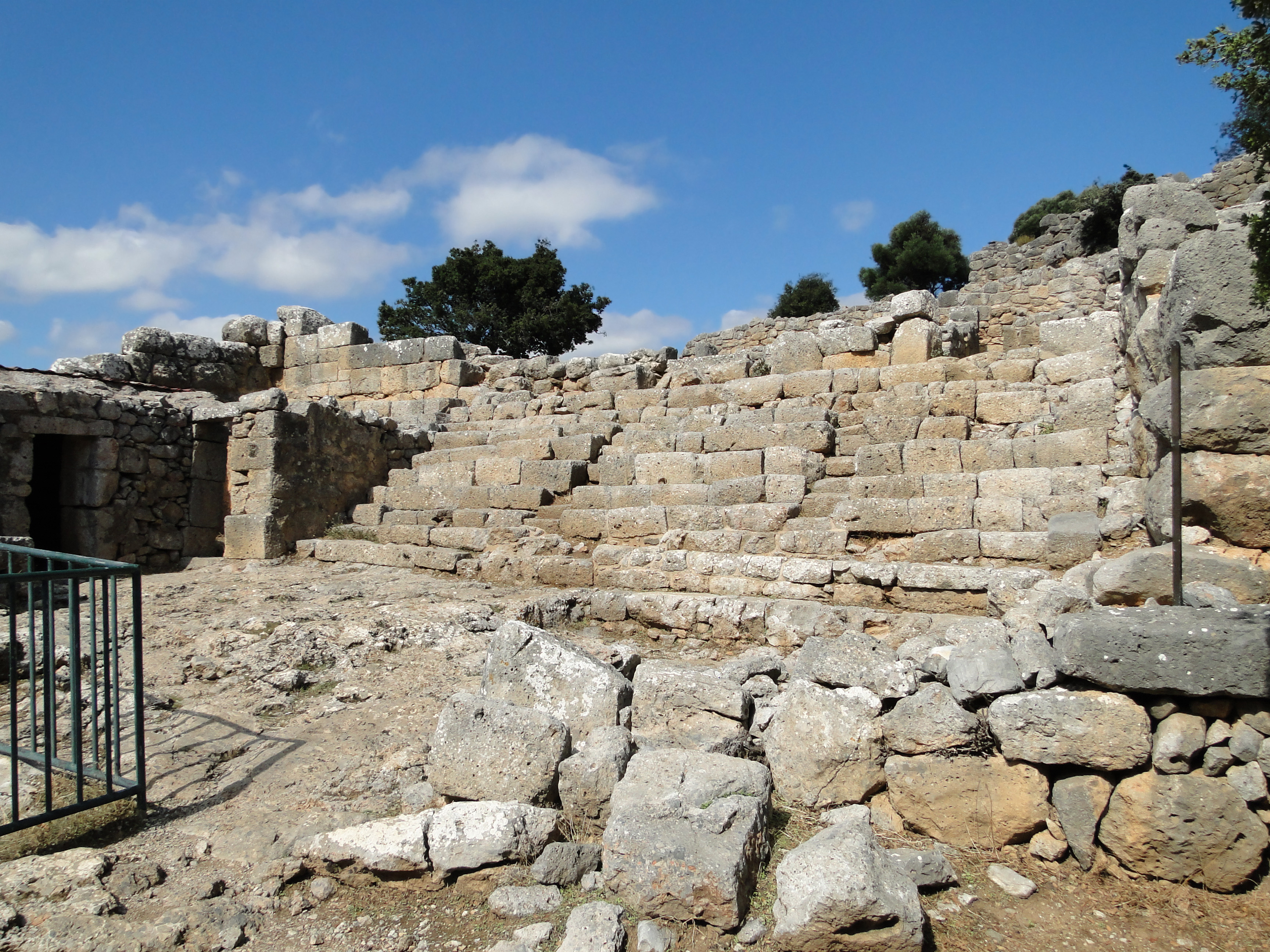|
Siege Of Naxos (499 BC)
The siege of Naxos (499 BC) was a failed attempt by the Milesian tyrant Aristagoras, operating with support from, and in the name of the Persian Empire of Darius the Great, to conquer the island of Naxos. It was the opening act of the Greco-Persian Wars, which would ultimately last for 50 years. Aristagoras had been approached by exiled Naxian aristocrats, who were seeking to return to their island. Seeing an opportunity to bolster his position in Miletus, Aristagoras sought the help of his overlord, the Persian king Darius the Great, and the local satrap, Artaphernes to conquer Naxos. Consenting to the expedition, the Persians assembled a force of 200 triremes under the command of Megabates. The expedition quickly descended into a debacle. Aristagoras and Megabates quarreled on the journey to Naxos, and someone (possibly Megabates) informed the Naxians of the imminent arrival of the force. When they arrived, the Persians and Ionians were thus faced with a city well prepared to ... [...More Info...] [...Related Items...] OR: [Wikipedia] [Google] [Baidu] |
Greco-Persian Wars
The Greco-Persian Wars (also often called the Persian Wars) were a series of conflicts between the Achaemenid Empire and Greek city-states that started in 499 BC and lasted until 449 BC. The collision between the fractious political world of the Greeks and the enormous empire of the Persians began when Cyrus the Great conquered the Greek-inhabited region of Ionia in 547 BC. Struggling to control the independent-minded cities of Ionia, the Persians appointed tyrants to rule each of them. This would prove to be the source of much trouble for the Greeks and Persians alike. In 499 BC, the tyrant of Miletus, Aristagoras, embarked on an expedition to conquer the island of Naxos, with Persian support; however, the expedition was a debacle and, preempting his dismissal, Aristagoras incited all of Hellenic Asia Minor into rebellion against the Persians. This was the beginning of the Ionian Revolt, which would last until 493 BC, progressively drawing more regions of Asia Minor into the co ... [...More Info...] [...Related Items...] OR: [Wikipedia] [Google] [Baidu] |
Eretria
Eretria (; el, Ερέτρια, , grc, Ἐρέτρια, , literally 'city of the rowers') is a town in Euboea, Greece, facing the coast of Attica across the narrow South Euboean Gulf. It was an important Greek polis in the 6th and 5th century BC, mentioned by many famous writers and actively involved in significant historical events. Excavations of the ancient city began in the 1890s and have been conducted since 1964 by the Greek Archaeological Service (11th Ephorate of Antiquities) and the Swiss School of Archaeology in Greece. History of Eretria Prehistory The first evidence for human activity in the area of Eretria are pottery shards and stone artifacts from the late Neolithic period (3500–3000 BC) found on the Acropolis as well as in the plain. No permanent structures have yet been found. It is therefore unclear whether a permanent settlement existed at that time. The first known settlement from the Early Helladic period (3000–2000 BC) was located on the plain ... [...More Info...] [...Related Items...] OR: [Wikipedia] [Google] [Baidu] |
Ephesus
Ephesus (; grc-gre, Ἔφεσος, Éphesos; tr, Efes; may ultimately derive from hit, 𒀀𒉺𒊭, Apaša) was a city in ancient Greece on the coast of Ionia, southwest of present-day Selçuk in İzmir Province, Turkey. It was built in the 10th century BC on the site of Apasa, the former Arzawan capital, by Attica, Attic and Ionians, Ionian Greek colonists. During the Classical Greece, Classical Greek era, it was one of twelve cities that were members of the Ionian League. The city came under the control of the Roman Republic in 129 BC. The city was famous in its day for the nearby Temple of Artemis (completed around 550 BC), which has been designated one of the Seven Wonders of the Ancient World. Its many monumental buildings included the Library of Celsus and a theatre capable of holding 24,000 spectators. Ephesus was recipient city of one of the Pauline epistles; one of the seven churches of Asia addressed in the Book of Revelation; the Gospel of John may have b ... [...More Info...] [...Related Items...] OR: [Wikipedia] [Google] [Baidu] |
Priene
Priene ( grc, Πριήνη, Priēnē; tr, Prien) was an Ancient Greece, ancient Greek city of Ionia (and member of the Ionian League) located at the base of an escarpment of Mycale, about north of what was then the course of the Maeander River (now called the Büyük Menderes River, ''Büyük Menderes'' or "Big Maeander"). It was from ancient Aydın, Anthea, from ancient Söke, Aneon and from ancient Miletus. The city was built on the sea coast, overlooking the former Latmian Gulf of the Aegean Sea, Aegean. It was developed on steep slopes and terraces extending from sea level to a height of above sea level at the top of the escarpment. Because of siltation from the river filling the bay over several centuries, the city is now an inland site. It is located at a short distance west of the modern village Güllübahçe Turun in the Söke district of Aydın Province, Turkey. Priene is known to have been the site of high-quality Hellenistic art and architecture. The city's origi ... [...More Info...] [...Related Items...] OR: [Wikipedia] [Google] [Baidu] |
Myus
Myus ( grc, Μυοῦς), sometimes Myous or Myos, was an ancient Greek city in Caria. It was one of twelve major settlements of the Ionian League. The city was said to have been founded by Cyaretus ( grc, Κυάρητος) (sometimes called Cydrelus), a son of Codrus. Myus was located on a small peninsula at the coast of the Aegean Sea, but it now lies inland due to the sediment deposited by the Maeander River over many centuries. The site of the city lies north of the modern village Avşar in the Söke district of Aydın Province, Turkey Myus was synoikised with Miletus. Myus had both a temple of Athena and a temple of Herodotus and sources tell us that it was always secondary to Miletos. Instigated by Aristagoras of Miletus, the Ionian Revolt broke out here. It was the beginning of the Greco-Persian Wars. It was the smallest among the twelve Ionian cities, and in the days of Strabo the population was so reduced that they did not form a political community, but became ... [...More Info...] [...Related Items...] OR: [Wikipedia] [Google] [Baidu] |
Ionia
Ionia () was an ancient region on the western coast of Anatolia, to the south of present-day Izmir. It consisted of the northernmost territories of the Ionian League of Greek settlements. Never a unified state, it was named after the Ionian tribe who had settled in the region before the Archaic period. Ionia proper comprised a narrow coastal strip from Phocaea in the north near the mouth of the river Hermus (now the Gediz), to Miletus in the south near the mouth of the river Maeander, and included the islands of Chios and Samos. It was bounded by Aeolia to the north, Lydia to the east and Caria to the south. The cities within the region figured large in the strife between the Persian Empire and the Greeks. Ionian cities were identified by mythic traditions of kinship and by their use of the Ionic dialect, but there was a core group of twelve Ionian cities who formed the Ionian League and had a shared sanctuary and festival at Panionion. These twelve cities were (from ... [...More Info...] [...Related Items...] OR: [Wikipedia] [Google] [Baidu] |
Lydia
Lydia (Lydian language, Lydian: 𐤮𐤱𐤠𐤭𐤣𐤠, ''Śfarda''; Aramaic: ''Lydia''; el, Λυδία, ''Lȳdíā''; tr, Lidya) was an Iron Age Monarchy, kingdom of western Asia Minor located generally east of ancient Ionia in the modern western Turkey, Turkish provinces of Uşak Province, Uşak, Manisa Province, Manisa and inland Izmir Province, Izmir. The ethnic group inhabiting this kingdom are known as the Lydians, and their language, known as Lydian language, Lydian, was a member of the Anatolian languages, Anatolian branch of the Indo-European languages, Indo-European language family. The capital of Lydia was Sardis.Rhodes, P.J. ''A History of the Classical Greek World 478–323 BC''. 2nd edition. Chichester: Wiley-Blackwell, 2010, p. 6. The Kingdom of Lydia existed from about 1200 BC to 546 BC. At its greatest extent, during the 7th century BC, it covered all of western Anatolia. In 546 BC, it became a province of the Achaemenid Empire, Achaemenid Persian Empire ... [...More Info...] [...Related Items...] OR: [Wikipedia] [Google] [Baidu] |
Ionians
The Ionians (; el, Ἴωνες, ''Íōnes'', singular , ''Íōn'') were one of the four major tribes that the Greeks considered themselves to be divided into during the ancient period; the other three being the Dorians, Aeolians, and Achaeans. The Ionian dialect was one of the three major linguistic divisions of the Hellenic world, together with the Dorian and Aeolian dialects. When referring to populations, “''Ionian''” defines several groups in Classical Greece. In its narrowest sense, the term referred to the region of Ionia in Asia Minor. In a broader sense, it could be used to describe all speakers of the Ionic dialect, which in addition to those in Ionia proper also included the Greek populations of Euboea, the Cyclades, and many cities founded by Ionian colonists. Finally, in the broadest sense it could be used to describe all those who spoke languages of the East Greek group, which included Attic. The foundation myth which was current in the Classical p ... [...More Info...] [...Related Items...] OR: [Wikipedia] [Google] [Baidu] |
Dorians
The Dorians (; el, Δωριεῖς, ''Dōrieîs'', singular , ''Dōrieús'') were one of the four major ethnic groups into which the Hellenes (or Greeks) of Classical Greece divided themselves (along with the Aeolians, Achaeans, and Ionians). They are almost always referred to as just "the Dorians", as they are called in the earliest literary mention of them in the ''Odyssey'', where they already can be found inhabiting the island of Crete. They were diverse in way of life and social organization, varying from the populous trade center of the city of Corinth, known for its ornate style in art and architecture, to the isolationist, military state of Sparta. And yet, all Hellenes knew which localities were Dorian, and which were not. Dorian states at war could more likely, but not always, count on the assistance of other Dorian states. Dorians were distinguished by the Doric Greek dialect and by characteristic social and historical traditions. In the 5th century BC, Dorians an ... [...More Info...] [...Related Items...] OR: [Wikipedia] [Google] [Baidu] |
Aeolians
The Aeolians (; el, Αἰολεῖς) were one of the four major tribes in which Greeks divided themselves in the ancient period (along with the Achaeans, Dorians and Ionians).. Name Their name mythologically derives from Aeolus, the mythical ancestor of the Aeolians and son of Hellen, the mythical patriarch of the Greek nation; it actually comes from Greek term ''aiolos'' (αίολος) meaning "quickly moving". The dialect of ancient Greek they spoke is referred to as Aeolic. History Originating in Thessaly, a part of which was called Aeolis, the Aeolians often appear as the most numerous amongst the other Hellenic tribes of early times. The Boeotians, a subgroup of the Aeolians, were driven from Thessaly by the Thessalians and moved their location to Boeotia. Aeolian peoples were spread in many other parts of Greece such as Aetolia, Locris, Corinth, Elis and Messinia. During the Dorian invasion, Aeolians from Thessaly fled across the Aegean Sea to the island of Lesbos and ... [...More Info...] [...Related Items...] OR: [Wikipedia] [Google] [Baidu] |
Asia Minor
Anatolia, tr, Anadolu Yarımadası), and the Anatolian plateau, also known as Asia Minor, is a large peninsula in Western Asia and the westernmost protrusion of the Asian continent. It constitutes the major part of modern-day Turkey. The region is bounded by the Turkish Straits to the northwest, the Black Sea to the north, the Armenian Highlands to the east, the Mediterranean Sea to the south, and the Aegean Sea to the west. The Sea of Marmara forms a connection between the Black and Aegean seas through the Bosporus and Dardanelles straits and separates Anatolia from Thrace on the Balkan peninsula of Southeast Europe. The eastern border of Anatolia has been held to be a line between the Gulf of Alexandretta and the Black Sea, bounded by the Armenian Highlands to the east and Mesopotamia to the southeast. By this definition Anatolia comprises approximately the western two-thirds of the Asian part of Turkey. Today, Anatolia is sometimes considered to be synonymous with Asia ... [...More Info...] [...Related Items...] OR: [Wikipedia] [Google] [Baidu] |
Mycenaean Greece
Mycenaean Greece (or the Mycenaean civilization) was the last phase of the Bronze Age The Bronze Age is a historic period, lasting approximately from 3300 BC to 1200 BC, characterized by the use of bronze, the presence of writing in some areas, and other early features of urban civilization. The Bronze Age is the second pri ... in Ancient Greece, spanning the period from approximately 1750 to 1050 BC.. It represents the first advanced and distinctively Greek civilization in mainland Greece with its palatial states, urban organization, works of art, and writing system.Lazaridis, Iosif et al.Genetic origins of the Minoans and Mycenaeans. ''Nature'', 2017Supplementary Information "The Mycenaeans", pp. 2–3).. The Mycenaeans were mainland Greeks, Greek peoples who were likely stimulated by their contact with insular Minoan civilization, Minoan Crete and other Mediterranean Sea, Mediterranean cultures to develop a more sophisticated sociopolitical culture of their own. The ... [...More Info...] [...Related Items...] OR: [Wikipedia] [Google] [Baidu] |











.jpg)